Brand Strategy and Management for Amazon Alexa
VerifiedAdded on 2023/06/05
|11
|3688
|264
AI Summary
This study material from Desklib discusses the brand strategy and management of Amazon Alexa, a smart speaker and personal assistant. It covers its core brand values, brand communication, secondary brand association, and evaluation. Alexa is a product of Amazon and has been introduced with the objective of fulfilling customers’ demands and wants and to provide them unique experience through which separate image could be developed amongst the target audience in order to gain competitive advantage.
Contribute Materials
Your contribution can guide someone’s learning journey. Share your
documents today.

Brand Strategy and Management 1 | P a g e
Brand Strategy and Management
Brand Strategy and Management
Secure Best Marks with AI Grader
Need help grading? Try our AI Grader for instant feedback on your assignments.
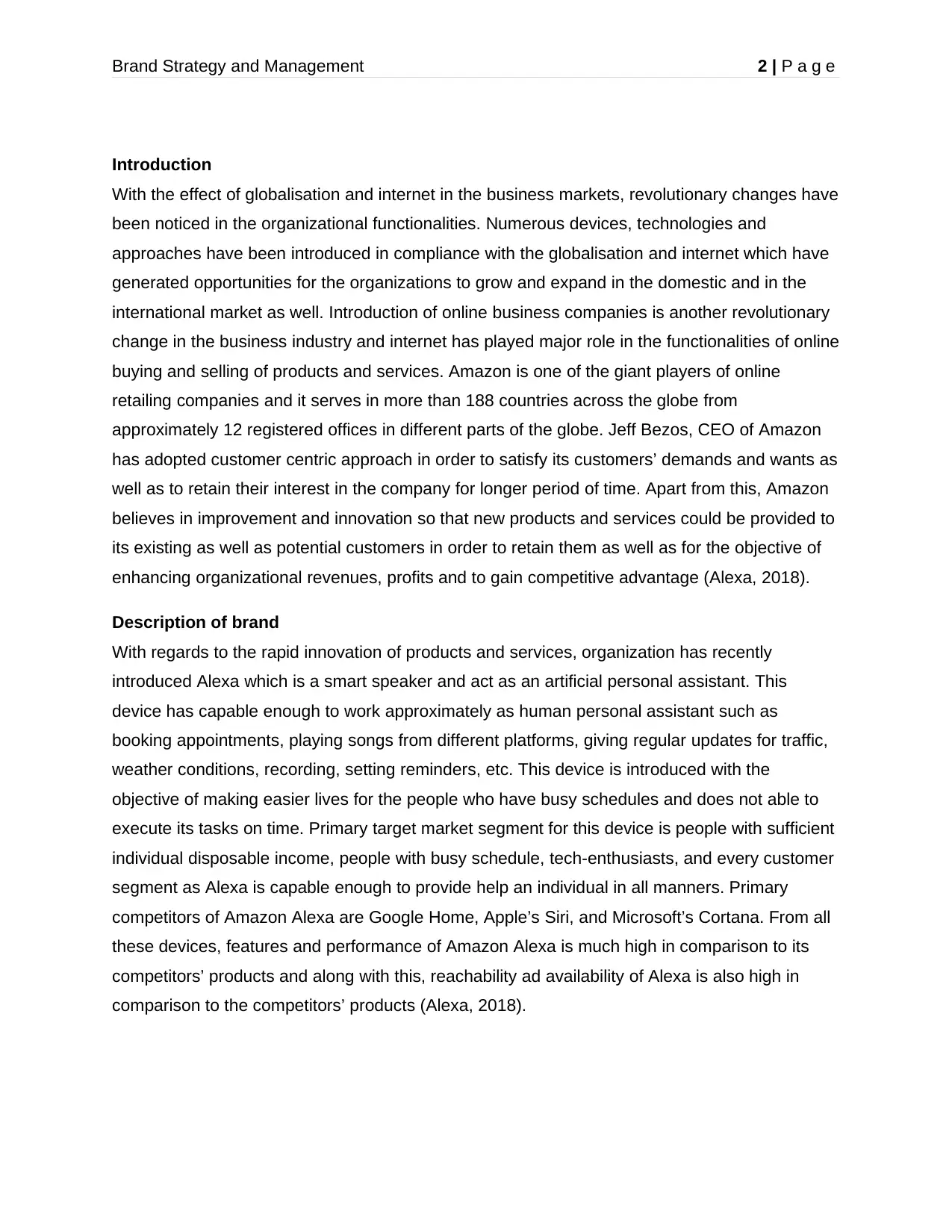
Brand Strategy and Management 2 | P a g e
Introduction
With the effect of globalisation and internet in the business markets, revolutionary changes have
been noticed in the organizational functionalities. Numerous devices, technologies and
approaches have been introduced in compliance with the globalisation and internet which have
generated opportunities for the organizations to grow and expand in the domestic and in the
international market as well. Introduction of online business companies is another revolutionary
change in the business industry and internet has played major role in the functionalities of online
buying and selling of products and services. Amazon is one of the giant players of online
retailing companies and it serves in more than 188 countries across the globe from
approximately 12 registered offices in different parts of the globe. Jeff Bezos, CEO of Amazon
has adopted customer centric approach in order to satisfy its customers’ demands and wants as
well as to retain their interest in the company for longer period of time. Apart from this, Amazon
believes in improvement and innovation so that new products and services could be provided to
its existing as well as potential customers in order to retain them as well as for the objective of
enhancing organizational revenues, profits and to gain competitive advantage (Alexa, 2018).
Description of brand
With regards to the rapid innovation of products and services, organization has recently
introduced Alexa which is a smart speaker and act as an artificial personal assistant. This
device has capable enough to work approximately as human personal assistant such as
booking appointments, playing songs from different platforms, giving regular updates for traffic,
weather conditions, recording, setting reminders, etc. This device is introduced with the
objective of making easier lives for the people who have busy schedules and does not able to
execute its tasks on time. Primary target market segment for this device is people with sufficient
individual disposable income, people with busy schedule, tech-enthusiasts, and every customer
segment as Alexa is capable enough to provide help an individual in all manners. Primary
competitors of Amazon Alexa are Google Home, Apple’s Siri, and Microsoft’s Cortana. From all
these devices, features and performance of Amazon Alexa is much high in comparison to its
competitors’ products and along with this, reachability ad availability of Alexa is also high in
comparison to the competitors’ products (Alexa, 2018).
Introduction
With the effect of globalisation and internet in the business markets, revolutionary changes have
been noticed in the organizational functionalities. Numerous devices, technologies and
approaches have been introduced in compliance with the globalisation and internet which have
generated opportunities for the organizations to grow and expand in the domestic and in the
international market as well. Introduction of online business companies is another revolutionary
change in the business industry and internet has played major role in the functionalities of online
buying and selling of products and services. Amazon is one of the giant players of online
retailing companies and it serves in more than 188 countries across the globe from
approximately 12 registered offices in different parts of the globe. Jeff Bezos, CEO of Amazon
has adopted customer centric approach in order to satisfy its customers’ demands and wants as
well as to retain their interest in the company for longer period of time. Apart from this, Amazon
believes in improvement and innovation so that new products and services could be provided to
its existing as well as potential customers in order to retain them as well as for the objective of
enhancing organizational revenues, profits and to gain competitive advantage (Alexa, 2018).
Description of brand
With regards to the rapid innovation of products and services, organization has recently
introduced Alexa which is a smart speaker and act as an artificial personal assistant. This
device has capable enough to work approximately as human personal assistant such as
booking appointments, playing songs from different platforms, giving regular updates for traffic,
weather conditions, recording, setting reminders, etc. This device is introduced with the
objective of making easier lives for the people who have busy schedules and does not able to
execute its tasks on time. Primary target market segment for this device is people with sufficient
individual disposable income, people with busy schedule, tech-enthusiasts, and every customer
segment as Alexa is capable enough to provide help an individual in all manners. Primary
competitors of Amazon Alexa are Google Home, Apple’s Siri, and Microsoft’s Cortana. From all
these devices, features and performance of Amazon Alexa is much high in comparison to its
competitors’ products and along with this, reachability ad availability of Alexa is also high in
comparison to the competitors’ products (Alexa, 2018).
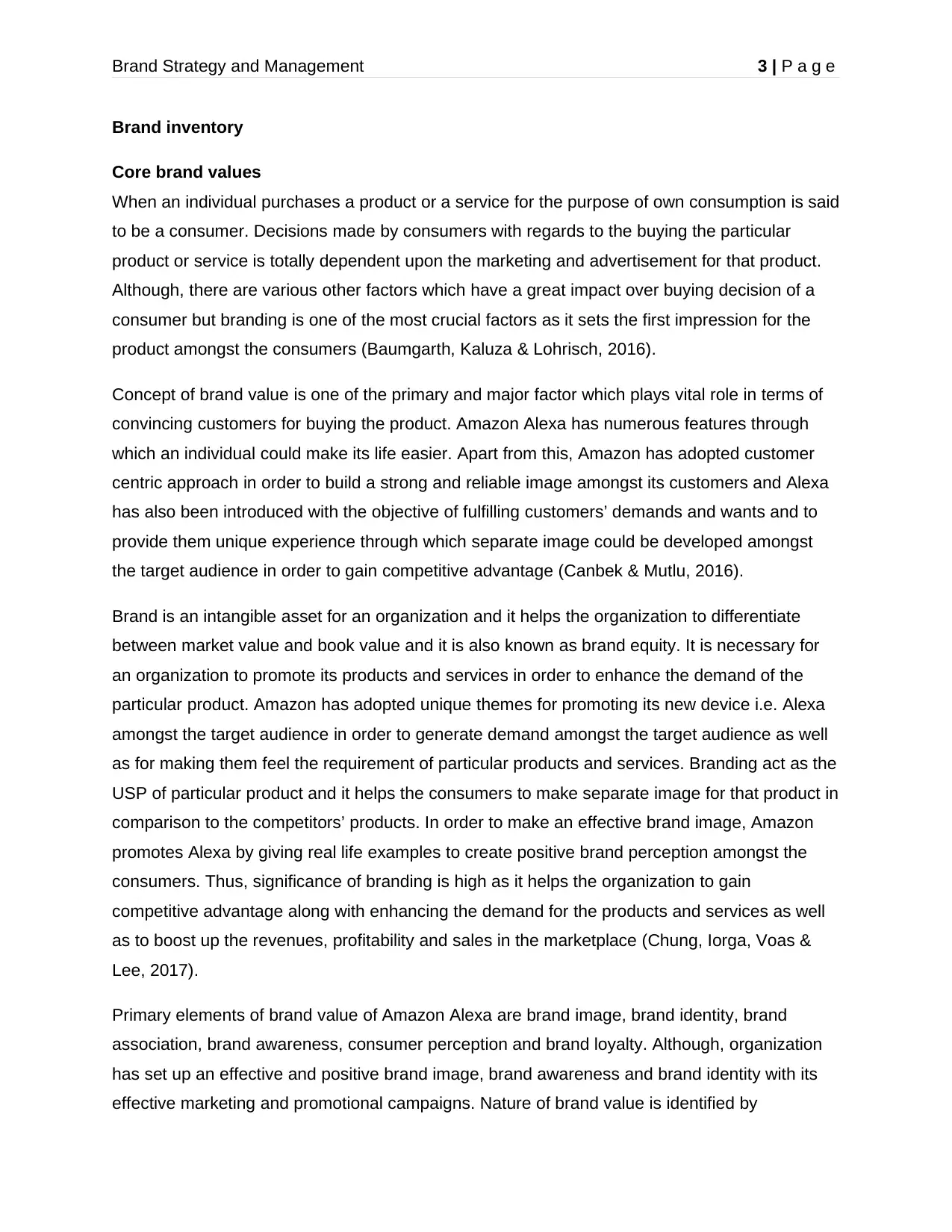
Brand Strategy and Management 3 | P a g e
Brand inventory
Core brand values
When an individual purchases a product or a service for the purpose of own consumption is said
to be a consumer. Decisions made by consumers with regards to the buying the particular
product or service is totally dependent upon the marketing and advertisement for that product.
Although, there are various other factors which have a great impact over buying decision of a
consumer but branding is one of the most crucial factors as it sets the first impression for the
product amongst the consumers (Baumgarth, Kaluza & Lohrisch, 2016).
Concept of brand value is one of the primary and major factor which plays vital role in terms of
convincing customers for buying the product. Amazon Alexa has numerous features through
which an individual could make its life easier. Apart from this, Amazon has adopted customer
centric approach in order to build a strong and reliable image amongst its customers and Alexa
has also been introduced with the objective of fulfilling customers’ demands and wants and to
provide them unique experience through which separate image could be developed amongst
the target audience in order to gain competitive advantage (Canbek & Mutlu, 2016).
Brand is an intangible asset for an organization and it helps the organization to differentiate
between market value and book value and it is also known as brand equity. It is necessary for
an organization to promote its products and services in order to enhance the demand of the
particular product. Amazon has adopted unique themes for promoting its new device i.e. Alexa
amongst the target audience in order to generate demand amongst the target audience as well
as for making them feel the requirement of particular products and services. Branding act as the
USP of particular product and it helps the consumers to make separate image for that product in
comparison to the competitors’ products. In order to make an effective brand image, Amazon
promotes Alexa by giving real life examples to create positive brand perception amongst the
consumers. Thus, significance of branding is high as it helps the organization to gain
competitive advantage along with enhancing the demand for the products and services as well
as to boost up the revenues, profitability and sales in the marketplace (Chung, Iorga, Voas &
Lee, 2017).
Primary elements of brand value of Amazon Alexa are brand image, brand identity, brand
association, brand awareness, consumer perception and brand loyalty. Although, organization
has set up an effective and positive brand image, brand awareness and brand identity with its
effective marketing and promotional campaigns. Nature of brand value is identified by
Brand inventory
Core brand values
When an individual purchases a product or a service for the purpose of own consumption is said
to be a consumer. Decisions made by consumers with regards to the buying the particular
product or service is totally dependent upon the marketing and advertisement for that product.
Although, there are various other factors which have a great impact over buying decision of a
consumer but branding is one of the most crucial factors as it sets the first impression for the
product amongst the consumers (Baumgarth, Kaluza & Lohrisch, 2016).
Concept of brand value is one of the primary and major factor which plays vital role in terms of
convincing customers for buying the product. Amazon Alexa has numerous features through
which an individual could make its life easier. Apart from this, Amazon has adopted customer
centric approach in order to build a strong and reliable image amongst its customers and Alexa
has also been introduced with the objective of fulfilling customers’ demands and wants and to
provide them unique experience through which separate image could be developed amongst
the target audience in order to gain competitive advantage (Canbek & Mutlu, 2016).
Brand is an intangible asset for an organization and it helps the organization to differentiate
between market value and book value and it is also known as brand equity. It is necessary for
an organization to promote its products and services in order to enhance the demand of the
particular product. Amazon has adopted unique themes for promoting its new device i.e. Alexa
amongst the target audience in order to generate demand amongst the target audience as well
as for making them feel the requirement of particular products and services. Branding act as the
USP of particular product and it helps the consumers to make separate image for that product in
comparison to the competitors’ products. In order to make an effective brand image, Amazon
promotes Alexa by giving real life examples to create positive brand perception amongst the
consumers. Thus, significance of branding is high as it helps the organization to gain
competitive advantage along with enhancing the demand for the products and services as well
as to boost up the revenues, profitability and sales in the marketplace (Chung, Iorga, Voas &
Lee, 2017).
Primary elements of brand value of Amazon Alexa are brand image, brand identity, brand
association, brand awareness, consumer perception and brand loyalty. Although, organization
has set up an effective and positive brand image, brand awareness and brand identity with its
effective marketing and promotional campaigns. Nature of brand value is identified by
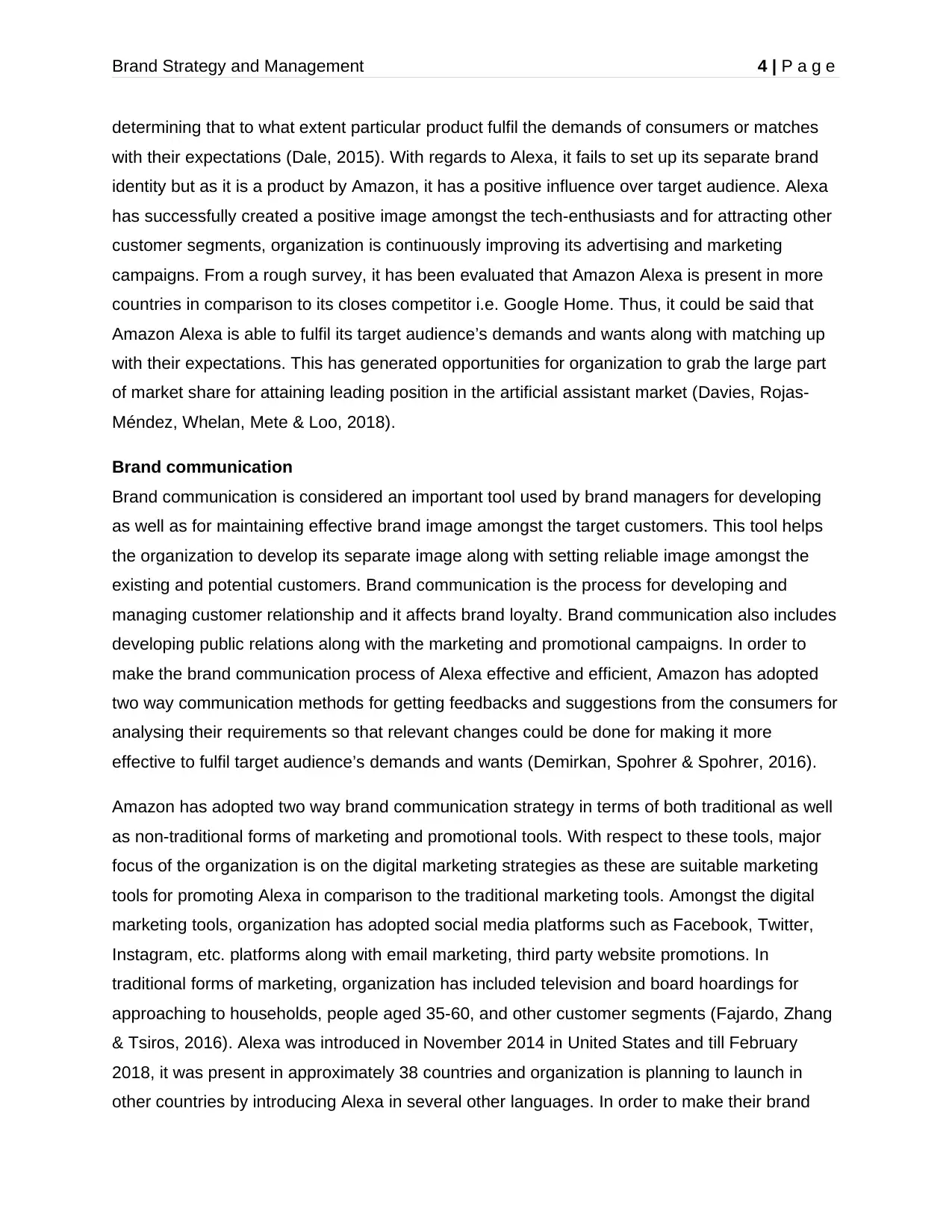
Brand Strategy and Management 4 | P a g e
determining that to what extent particular product fulfil the demands of consumers or matches
with their expectations (Dale, 2015). With regards to Alexa, it fails to set up its separate brand
identity but as it is a product by Amazon, it has a positive influence over target audience. Alexa
has successfully created a positive image amongst the tech-enthusiasts and for attracting other
customer segments, organization is continuously improving its advertising and marketing
campaigns. From a rough survey, it has been evaluated that Amazon Alexa is present in more
countries in comparison to its closes competitor i.e. Google Home. Thus, it could be said that
Amazon Alexa is able to fulfil its target audience’s demands and wants along with matching up
with their expectations. This has generated opportunities for organization to grab the large part
of market share for attaining leading position in the artificial assistant market (Davies, Rojas-
Méndez, Whelan, Mete & Loo, 2018).
Brand communication
Brand communication is considered an important tool used by brand managers for developing
as well as for maintaining effective brand image amongst the target customers. This tool helps
the organization to develop its separate image along with setting reliable image amongst the
existing and potential customers. Brand communication is the process for developing and
managing customer relationship and it affects brand loyalty. Brand communication also includes
developing public relations along with the marketing and promotional campaigns. In order to
make the brand communication process of Alexa effective and efficient, Amazon has adopted
two way communication methods for getting feedbacks and suggestions from the consumers for
analysing their requirements so that relevant changes could be done for making it more
effective to fulfil target audience’s demands and wants (Demirkan, Spohrer & Spohrer, 2016).
Amazon has adopted two way brand communication strategy in terms of both traditional as well
as non-traditional forms of marketing and promotional tools. With respect to these tools, major
focus of the organization is on the digital marketing strategies as these are suitable marketing
tools for promoting Alexa in comparison to the traditional marketing tools. Amongst the digital
marketing tools, organization has adopted social media platforms such as Facebook, Twitter,
Instagram, etc. platforms along with email marketing, third party website promotions. In
traditional forms of marketing, organization has included television and board hoardings for
approaching to households, people aged 35-60, and other customer segments (Fajardo, Zhang
& Tsiros, 2016). Alexa was introduced in November 2014 in United States and till February
2018, it was present in approximately 38 countries and organization is planning to launch in
other countries by introducing Alexa in several other languages. In order to make their brand
determining that to what extent particular product fulfil the demands of consumers or matches
with their expectations (Dale, 2015). With regards to Alexa, it fails to set up its separate brand
identity but as it is a product by Amazon, it has a positive influence over target audience. Alexa
has successfully created a positive image amongst the tech-enthusiasts and for attracting other
customer segments, organization is continuously improving its advertising and marketing
campaigns. From a rough survey, it has been evaluated that Amazon Alexa is present in more
countries in comparison to its closes competitor i.e. Google Home. Thus, it could be said that
Amazon Alexa is able to fulfil its target audience’s demands and wants along with matching up
with their expectations. This has generated opportunities for organization to grab the large part
of market share for attaining leading position in the artificial assistant market (Davies, Rojas-
Méndez, Whelan, Mete & Loo, 2018).
Brand communication
Brand communication is considered an important tool used by brand managers for developing
as well as for maintaining effective brand image amongst the target customers. This tool helps
the organization to develop its separate image along with setting reliable image amongst the
existing and potential customers. Brand communication is the process for developing and
managing customer relationship and it affects brand loyalty. Brand communication also includes
developing public relations along with the marketing and promotional campaigns. In order to
make the brand communication process of Alexa effective and efficient, Amazon has adopted
two way communication methods for getting feedbacks and suggestions from the consumers for
analysing their requirements so that relevant changes could be done for making it more
effective to fulfil target audience’s demands and wants (Demirkan, Spohrer & Spohrer, 2016).
Amazon has adopted two way brand communication strategy in terms of both traditional as well
as non-traditional forms of marketing and promotional tools. With respect to these tools, major
focus of the organization is on the digital marketing strategies as these are suitable marketing
tools for promoting Alexa in comparison to the traditional marketing tools. Amongst the digital
marketing tools, organization has adopted social media platforms such as Facebook, Twitter,
Instagram, etc. platforms along with email marketing, third party website promotions. In
traditional forms of marketing, organization has included television and board hoardings for
approaching to households, people aged 35-60, and other customer segments (Fajardo, Zhang
& Tsiros, 2016). Alexa was introduced in November 2014 in United States and till February
2018, it was present in approximately 38 countries and organization is planning to launch in
other countries by introducing Alexa in several other languages. In order to make their brand
Secure Best Marks with AI Grader
Need help grading? Try our AI Grader for instant feedback on your assignments.
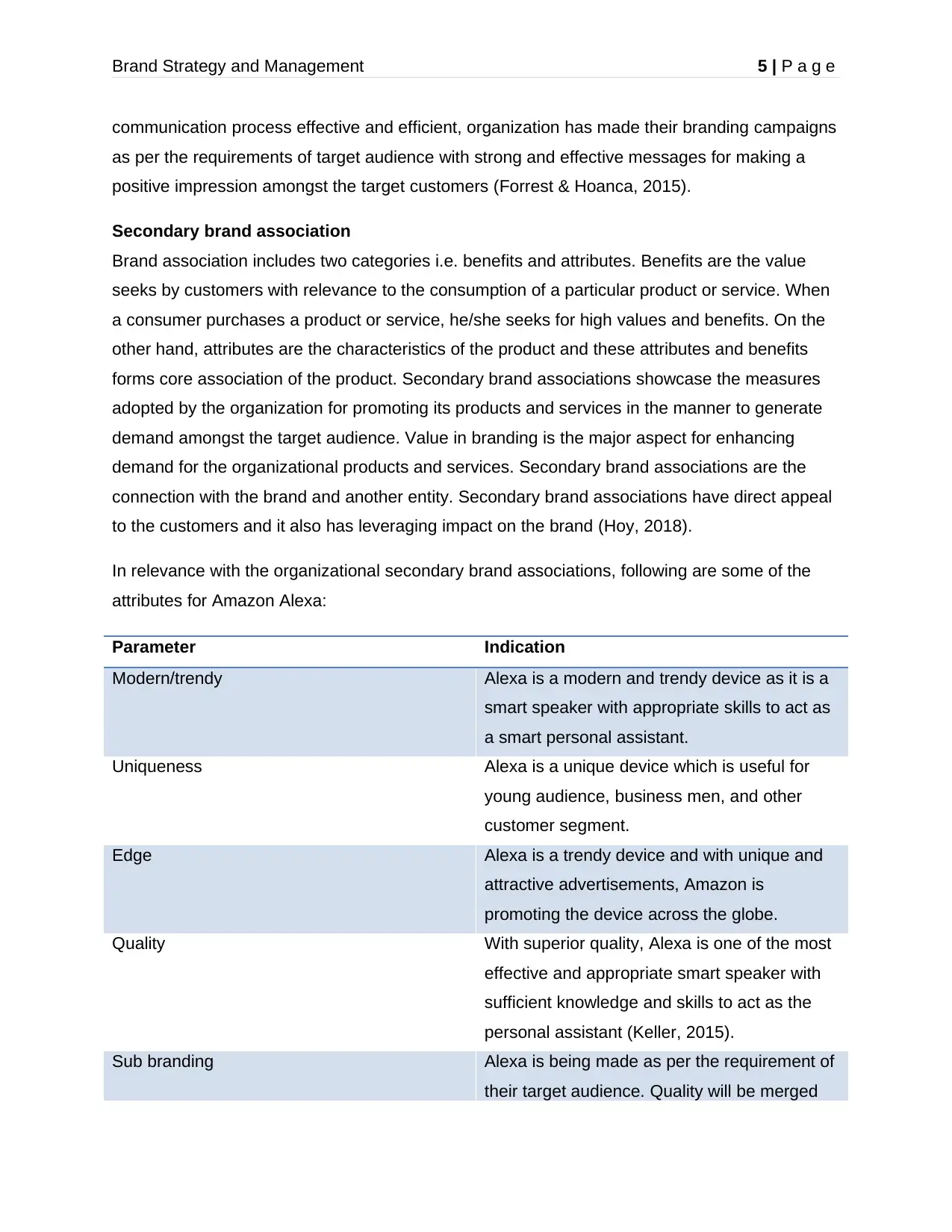
Brand Strategy and Management 5 | P a g e
communication process effective and efficient, organization has made their branding campaigns
as per the requirements of target audience with strong and effective messages for making a
positive impression amongst the target customers (Forrest & Hoanca, 2015).
Secondary brand association
Brand association includes two categories i.e. benefits and attributes. Benefits are the value
seeks by customers with relevance to the consumption of a particular product or service. When
a consumer purchases a product or service, he/she seeks for high values and benefits. On the
other hand, attributes are the characteristics of the product and these attributes and benefits
forms core association of the product. Secondary brand associations showcase the measures
adopted by the organization for promoting its products and services in the manner to generate
demand amongst the target audience. Value in branding is the major aspect for enhancing
demand for the organizational products and services. Secondary brand associations are the
connection with the brand and another entity. Secondary brand associations have direct appeal
to the customers and it also has leveraging impact on the brand (Hoy, 2018).
In relevance with the organizational secondary brand associations, following are some of the
attributes for Amazon Alexa:
Parameter Indication
Modern/trendy Alexa is a modern and trendy device as it is a
smart speaker with appropriate skills to act as
a smart personal assistant.
Uniqueness Alexa is a unique device which is useful for
young audience, business men, and other
customer segment.
Edge Alexa is a trendy device and with unique and
attractive advertisements, Amazon is
promoting the device across the globe.
Quality With superior quality, Alexa is one of the most
effective and appropriate smart speaker with
sufficient knowledge and skills to act as the
personal assistant (Keller, 2015).
Sub branding Alexa is being made as per the requirement of
their target audience. Quality will be merged
communication process effective and efficient, organization has made their branding campaigns
as per the requirements of target audience with strong and effective messages for making a
positive impression amongst the target customers (Forrest & Hoanca, 2015).
Secondary brand association
Brand association includes two categories i.e. benefits and attributes. Benefits are the value
seeks by customers with relevance to the consumption of a particular product or service. When
a consumer purchases a product or service, he/she seeks for high values and benefits. On the
other hand, attributes are the characteristics of the product and these attributes and benefits
forms core association of the product. Secondary brand associations showcase the measures
adopted by the organization for promoting its products and services in the manner to generate
demand amongst the target audience. Value in branding is the major aspect for enhancing
demand for the organizational products and services. Secondary brand associations are the
connection with the brand and another entity. Secondary brand associations have direct appeal
to the customers and it also has leveraging impact on the brand (Hoy, 2018).
In relevance with the organizational secondary brand associations, following are some of the
attributes for Amazon Alexa:
Parameter Indication
Modern/trendy Alexa is a modern and trendy device as it is a
smart speaker with appropriate skills to act as
a smart personal assistant.
Uniqueness Alexa is a unique device which is useful for
young audience, business men, and other
customer segment.
Edge Alexa is a trendy device and with unique and
attractive advertisements, Amazon is
promoting the device across the globe.
Quality With superior quality, Alexa is one of the most
effective and appropriate smart speaker with
sufficient knowledge and skills to act as the
personal assistant (Keller, 2015).
Sub branding Alexa is being made as per the requirement of
their target audience. Quality will be merged

Brand Strategy and Management 6 | P a g e
with appropriate skills and knowledge in order
to create brand association with the
customers.
Focus Organization is targeting different customer
segments and in order to approach to all
customer segments, organization is launching
Alexa in different language options in order to
fulfil customer’s needs and wants (Keller,
2016).
Evaluation
Positioning
Branding is one of the pivotal strategies for developing an effective position in the target market
with the objective of enhancing organizational performance in the target market along with
gaining desired goals and objectives such as attaining competitive advantage. Alexa is a smart
speaker and it is capable enough to provide appropriate information to its users along with
providing various other services like playing music, giving live updates of weather, sports and
other things and along with this, Alexa is also capable enough to book appointments on behalf
of its users. Thus, Alexa is useful for almost every customer segment and with regards to this;
organization is designing its advertisement and promotional campaigns on the basis of different
customer segments for generating demand and to gain competitive advantage (Business
Insider, 2018).
Core brand values of Alexa are its performance, uniqueness, quality, features and the brand
communication strategies through which Alexa has been introduced in approximately 38
countries in a very short period of time. Further, organization is planning to introduce in other
languages for making it effective for different customer segments as well as for the objective of
enhancing demand in the other parts of the globe. Apart from this, organizational brand
communication strategy is effective enough to promote in the target market along with
spreading awareness amongst different customer segments through which organizational goals
and objectives could easily be accomplished (Keller & Brexendorf, 2016).
with appropriate skills and knowledge in order
to create brand association with the
customers.
Focus Organization is targeting different customer
segments and in order to approach to all
customer segments, organization is launching
Alexa in different language options in order to
fulfil customer’s needs and wants (Keller,
2016).
Evaluation
Positioning
Branding is one of the pivotal strategies for developing an effective position in the target market
with the objective of enhancing organizational performance in the target market along with
gaining desired goals and objectives such as attaining competitive advantage. Alexa is a smart
speaker and it is capable enough to provide appropriate information to its users along with
providing various other services like playing music, giving live updates of weather, sports and
other things and along with this, Alexa is also capable enough to book appointments on behalf
of its users. Thus, Alexa is useful for almost every customer segment and with regards to this;
organization is designing its advertisement and promotional campaigns on the basis of different
customer segments for generating demand and to gain competitive advantage (Business
Insider, 2018).
Core brand values of Alexa are its performance, uniqueness, quality, features and the brand
communication strategies through which Alexa has been introduced in approximately 38
countries in a very short period of time. Further, organization is planning to introduce in other
languages for making it effective for different customer segments as well as for the objective of
enhancing demand in the other parts of the globe. Apart from this, organizational brand
communication strategy is effective enough to promote in the target market along with
spreading awareness amongst different customer segments through which organizational goals
and objectives could easily be accomplished (Keller & Brexendorf, 2016).
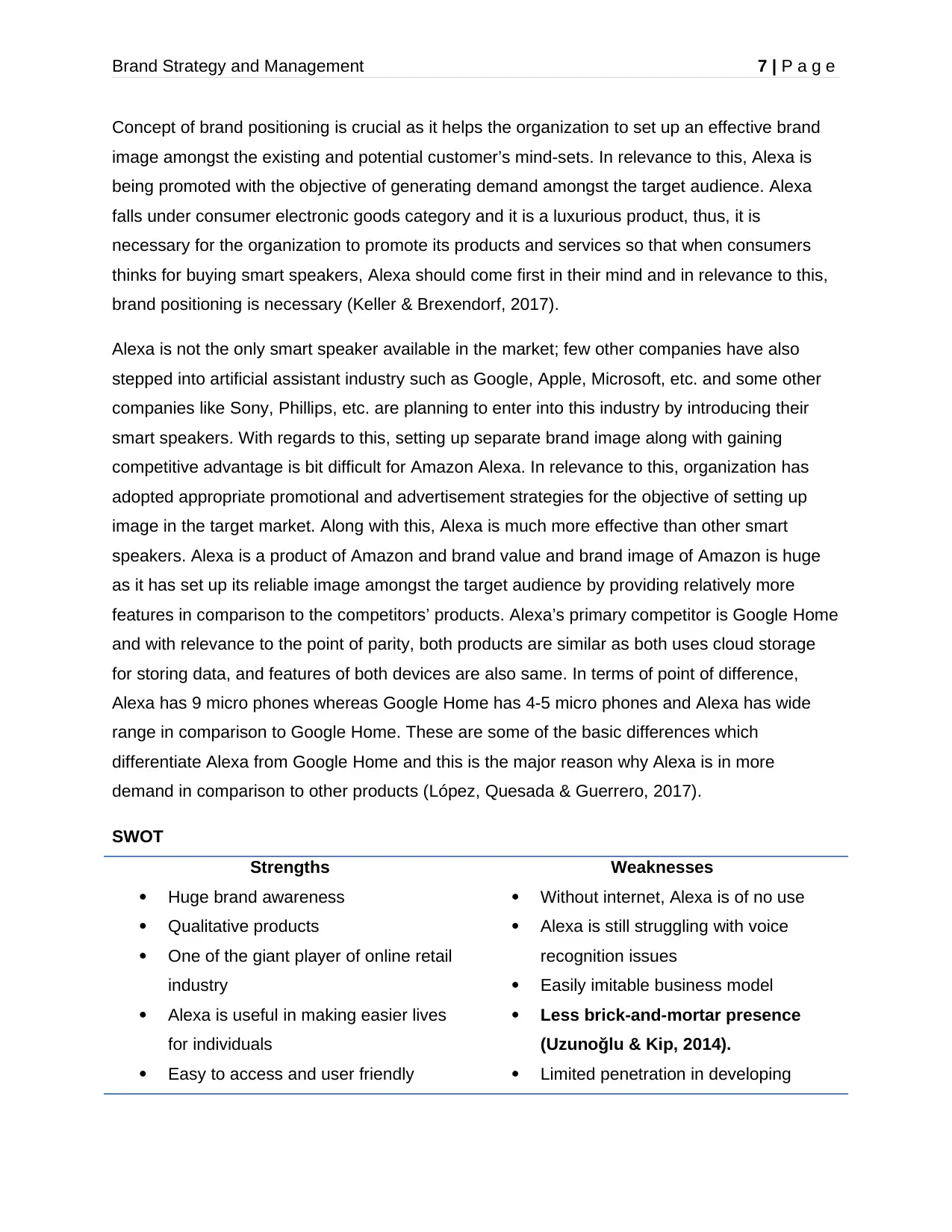
Brand Strategy and Management 7 | P a g e
Concept of brand positioning is crucial as it helps the organization to set up an effective brand
image amongst the existing and potential customer’s mind-sets. In relevance to this, Alexa is
being promoted with the objective of generating demand amongst the target audience. Alexa
falls under consumer electronic goods category and it is a luxurious product, thus, it is
necessary for the organization to promote its products and services so that when consumers
thinks for buying smart speakers, Alexa should come first in their mind and in relevance to this,
brand positioning is necessary (Keller & Brexendorf, 2017).
Alexa is not the only smart speaker available in the market; few other companies have also
stepped into artificial assistant industry such as Google, Apple, Microsoft, etc. and some other
companies like Sony, Phillips, etc. are planning to enter into this industry by introducing their
smart speakers. With regards to this, setting up separate brand image along with gaining
competitive advantage is bit difficult for Amazon Alexa. In relevance to this, organization has
adopted appropriate promotional and advertisement strategies for the objective of setting up
image in the target market. Along with this, Alexa is much more effective than other smart
speakers. Alexa is a product of Amazon and brand value and brand image of Amazon is huge
as it has set up its reliable image amongst the target audience by providing relatively more
features in comparison to the competitors’ products. Alexa’s primary competitor is Google Home
and with relevance to the point of parity, both products are similar as both uses cloud storage
for storing data, and features of both devices are also same. In terms of point of difference,
Alexa has 9 micro phones whereas Google Home has 4-5 micro phones and Alexa has wide
range in comparison to Google Home. These are some of the basic differences which
differentiate Alexa from Google Home and this is the major reason why Alexa is in more
demand in comparison to other products (López, Quesada & Guerrero, 2017).
SWOT
Strengths
Huge brand awareness
Qualitative products
One of the giant player of online retail
industry
Alexa is useful in making easier lives
for individuals
Easy to access and user friendly
Weaknesses
Without internet, Alexa is of no use
Alexa is still struggling with voice
recognition issues
Easily imitable business model
Less brick-and-mortar presence
(Uzunoğlu & Kip, 2014).
Limited penetration in developing
Concept of brand positioning is crucial as it helps the organization to set up an effective brand
image amongst the existing and potential customer’s mind-sets. In relevance to this, Alexa is
being promoted with the objective of generating demand amongst the target audience. Alexa
falls under consumer electronic goods category and it is a luxurious product, thus, it is
necessary for the organization to promote its products and services so that when consumers
thinks for buying smart speakers, Alexa should come first in their mind and in relevance to this,
brand positioning is necessary (Keller & Brexendorf, 2017).
Alexa is not the only smart speaker available in the market; few other companies have also
stepped into artificial assistant industry such as Google, Apple, Microsoft, etc. and some other
companies like Sony, Phillips, etc. are planning to enter into this industry by introducing their
smart speakers. With regards to this, setting up separate brand image along with gaining
competitive advantage is bit difficult for Amazon Alexa. In relevance to this, organization has
adopted appropriate promotional and advertisement strategies for the objective of setting up
image in the target market. Along with this, Alexa is much more effective than other smart
speakers. Alexa is a product of Amazon and brand value and brand image of Amazon is huge
as it has set up its reliable image amongst the target audience by providing relatively more
features in comparison to the competitors’ products. Alexa’s primary competitor is Google Home
and with relevance to the point of parity, both products are similar as both uses cloud storage
for storing data, and features of both devices are also same. In terms of point of difference,
Alexa has 9 micro phones whereas Google Home has 4-5 micro phones and Alexa has wide
range in comparison to Google Home. These are some of the basic differences which
differentiate Alexa from Google Home and this is the major reason why Alexa is in more
demand in comparison to other products (López, Quesada & Guerrero, 2017).
SWOT
Strengths
Huge brand awareness
Qualitative products
One of the giant player of online retail
industry
Alexa is useful in making easier lives
for individuals
Easy to access and user friendly
Weaknesses
Without internet, Alexa is of no use
Alexa is still struggling with voice
recognition issues
Easily imitable business model
Less brick-and-mortar presence
(Uzunoğlu & Kip, 2014).
Limited penetration in developing
Paraphrase This Document
Need a fresh take? Get an instant paraphrase of this document with our AI Paraphraser
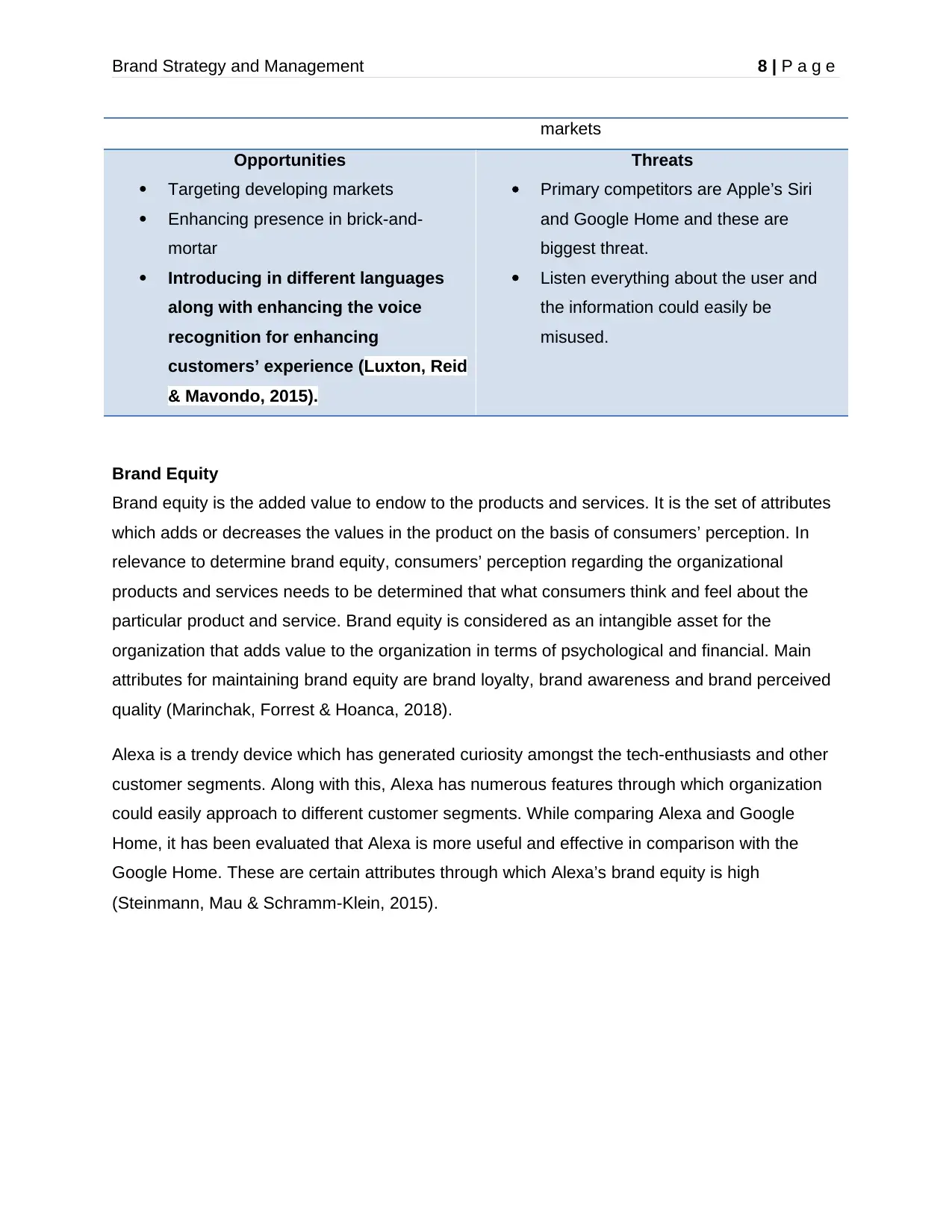
Brand Strategy and Management 8 | P a g e
markets
Opportunities
Targeting developing markets
Enhancing presence in brick-and-
mortar
Introducing in different languages
along with enhancing the voice
recognition for enhancing
customers’ experience (Luxton, Reid
& Mavondo, 2015).
Threats
Primary competitors are Apple’s Siri
and Google Home and these are
biggest threat.
Listen everything about the user and
the information could easily be
misused.
Brand Equity
Brand equity is the added value to endow to the products and services. It is the set of attributes
which adds or decreases the values in the product on the basis of consumers’ perception. In
relevance to determine brand equity, consumers’ perception regarding the organizational
products and services needs to be determined that what consumers think and feel about the
particular product and service. Brand equity is considered as an intangible asset for the
organization that adds value to the organization in terms of psychological and financial. Main
attributes for maintaining brand equity are brand loyalty, brand awareness and brand perceived
quality (Marinchak, Forrest & Hoanca, 2018).
Alexa is a trendy device which has generated curiosity amongst the tech-enthusiasts and other
customer segments. Along with this, Alexa has numerous features through which organization
could easily approach to different customer segments. While comparing Alexa and Google
Home, it has been evaluated that Alexa is more useful and effective in comparison with the
Google Home. These are certain attributes through which Alexa’s brand equity is high
(Steinmann, Mau & Schramm‐Klein, 2015).
markets
Opportunities
Targeting developing markets
Enhancing presence in brick-and-
mortar
Introducing in different languages
along with enhancing the voice
recognition for enhancing
customers’ experience (Luxton, Reid
& Mavondo, 2015).
Threats
Primary competitors are Apple’s Siri
and Google Home and these are
biggest threat.
Listen everything about the user and
the information could easily be
misused.
Brand Equity
Brand equity is the added value to endow to the products and services. It is the set of attributes
which adds or decreases the values in the product on the basis of consumers’ perception. In
relevance to determine brand equity, consumers’ perception regarding the organizational
products and services needs to be determined that what consumers think and feel about the
particular product and service. Brand equity is considered as an intangible asset for the
organization that adds value to the organization in terms of psychological and financial. Main
attributes for maintaining brand equity are brand loyalty, brand awareness and brand perceived
quality (Marinchak, Forrest & Hoanca, 2018).
Alexa is a trendy device which has generated curiosity amongst the tech-enthusiasts and other
customer segments. Along with this, Alexa has numerous features through which organization
could easily approach to different customer segments. While comparing Alexa and Google
Home, it has been evaluated that Alexa is more useful and effective in comparison with the
Google Home. These are certain attributes through which Alexa’s brand equity is high
(Steinmann, Mau & Schramm‐Klein, 2015).
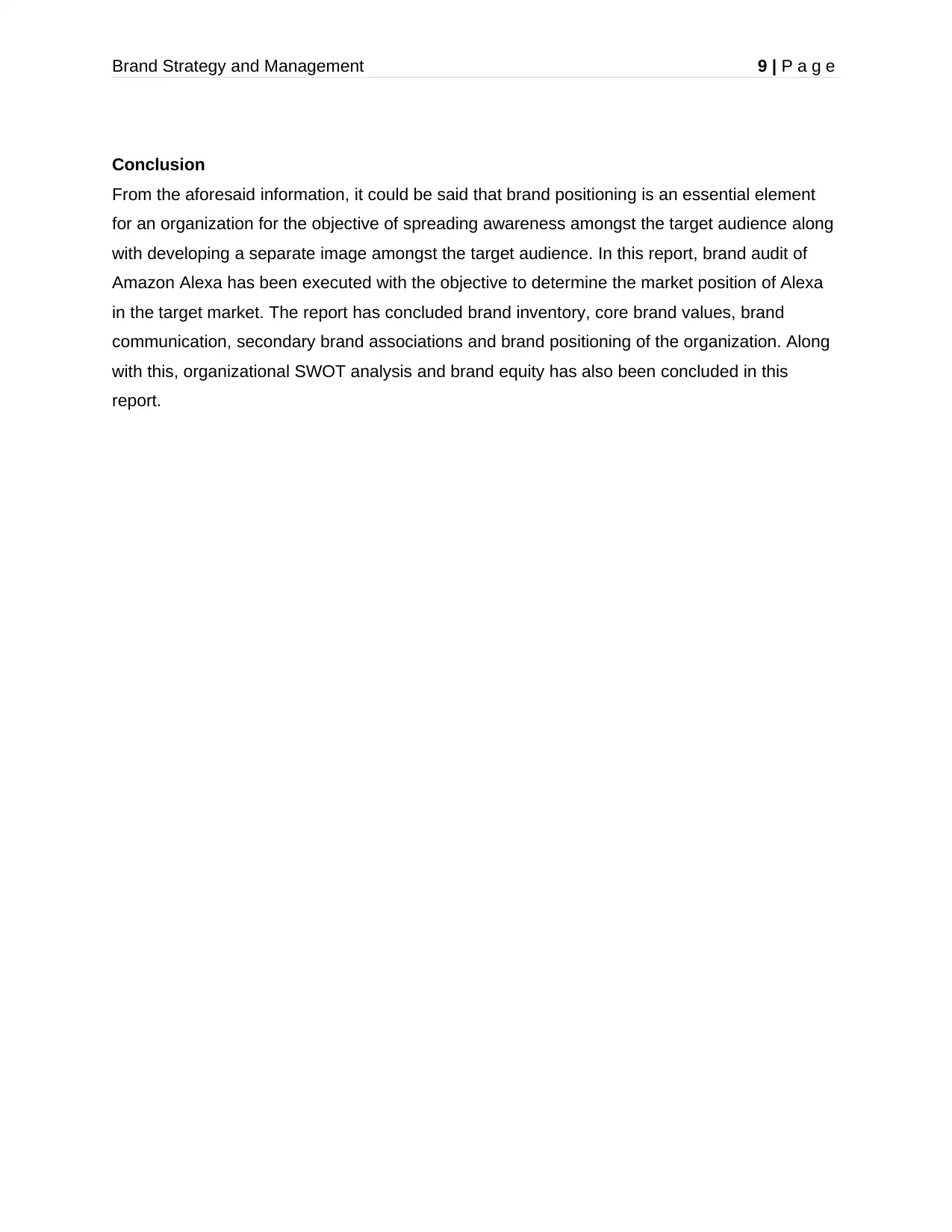
Brand Strategy and Management 9 | P a g e
Conclusion
From the aforesaid information, it could be said that brand positioning is an essential element
for an organization for the objective of spreading awareness amongst the target audience along
with developing a separate image amongst the target audience. In this report, brand audit of
Amazon Alexa has been executed with the objective to determine the market position of Alexa
in the target market. The report has concluded brand inventory, core brand values, brand
communication, secondary brand associations and brand positioning of the organization. Along
with this, organizational SWOT analysis and brand equity has also been concluded in this
report.
Conclusion
From the aforesaid information, it could be said that brand positioning is an essential element
for an organization for the objective of spreading awareness amongst the target audience along
with developing a separate image amongst the target audience. In this report, brand audit of
Amazon Alexa has been executed with the objective to determine the market position of Alexa
in the target market. The report has concluded brand inventory, core brand values, brand
communication, secondary brand associations and brand positioning of the organization. Along
with this, organizational SWOT analysis and brand equity has also been concluded in this
report.
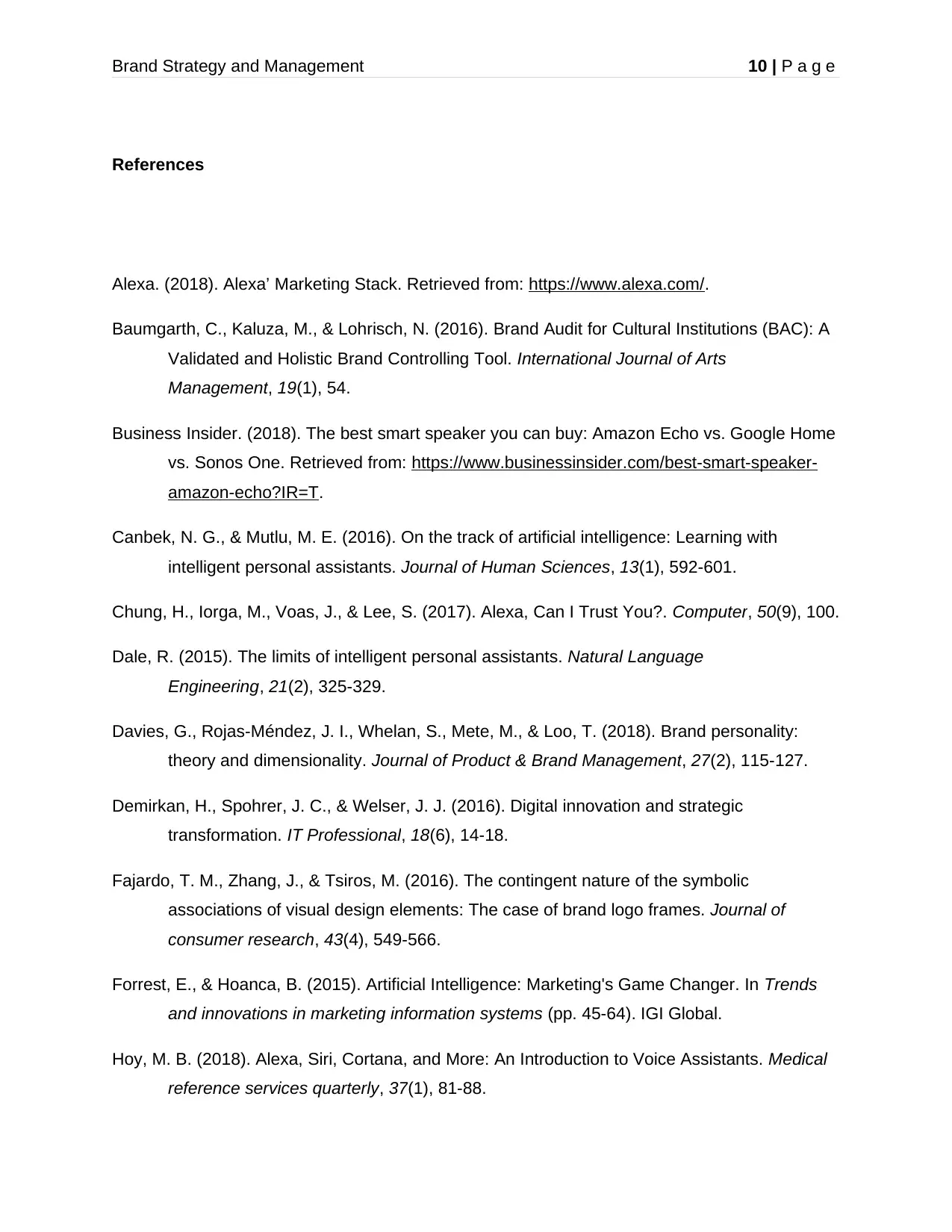
Brand Strategy and Management 10 | P a g e
References
Alexa. (2018). Alexa’ Marketing Stack. Retrieved from: https://www.alexa.com/.
Baumgarth, C., Kaluza, M., & Lohrisch, N. (2016). Brand Audit for Cultural Institutions (BAC): A
Validated and Holistic Brand Controlling Tool. International Journal of Arts
Management, 19(1), 54.
Business Insider. (2018). The best smart speaker you can buy: Amazon Echo vs. Google Home
vs. Sonos One. Retrieved from: https://www.businessinsider.com/best-smart-speaker-
amazon-echo?IR=T.
Canbek, N. G., & Mutlu, M. E. (2016). On the track of artificial intelligence: Learning with
intelligent personal assistants. Journal of Human Sciences, 13(1), 592-601.
Chung, H., Iorga, M., Voas, J., & Lee, S. (2017). Alexa, Can I Trust You?. Computer, 50(9), 100.
Dale, R. (2015). The limits of intelligent personal assistants. Natural Language
Engineering, 21(2), 325-329.
Davies, G., Rojas-Méndez, J. I., Whelan, S., Mete, M., & Loo, T. (2018). Brand personality:
theory and dimensionality. Journal of Product & Brand Management, 27(2), 115-127.
Demirkan, H., Spohrer, J. C., & Welser, J. J. (2016). Digital innovation and strategic
transformation. IT Professional, 18(6), 14-18.
Fajardo, T. M., Zhang, J., & Tsiros, M. (2016). The contingent nature of the symbolic
associations of visual design elements: The case of brand logo frames. Journal of
consumer research, 43(4), 549-566.
Forrest, E., & Hoanca, B. (2015). Artificial Intelligence: Marketing's Game Changer. In Trends
and innovations in marketing information systems (pp. 45-64). IGI Global.
Hoy, M. B. (2018). Alexa, Siri, Cortana, and More: An Introduction to Voice Assistants. Medical
reference services quarterly, 37(1), 81-88.
References
Alexa. (2018). Alexa’ Marketing Stack. Retrieved from: https://www.alexa.com/.
Baumgarth, C., Kaluza, M., & Lohrisch, N. (2016). Brand Audit for Cultural Institutions (BAC): A
Validated and Holistic Brand Controlling Tool. International Journal of Arts
Management, 19(1), 54.
Business Insider. (2018). The best smart speaker you can buy: Amazon Echo vs. Google Home
vs. Sonos One. Retrieved from: https://www.businessinsider.com/best-smart-speaker-
amazon-echo?IR=T.
Canbek, N. G., & Mutlu, M. E. (2016). On the track of artificial intelligence: Learning with
intelligent personal assistants. Journal of Human Sciences, 13(1), 592-601.
Chung, H., Iorga, M., Voas, J., & Lee, S. (2017). Alexa, Can I Trust You?. Computer, 50(9), 100.
Dale, R. (2015). The limits of intelligent personal assistants. Natural Language
Engineering, 21(2), 325-329.
Davies, G., Rojas-Méndez, J. I., Whelan, S., Mete, M., & Loo, T. (2018). Brand personality:
theory and dimensionality. Journal of Product & Brand Management, 27(2), 115-127.
Demirkan, H., Spohrer, J. C., & Welser, J. J. (2016). Digital innovation and strategic
transformation. IT Professional, 18(6), 14-18.
Fajardo, T. M., Zhang, J., & Tsiros, M. (2016). The contingent nature of the symbolic
associations of visual design elements: The case of brand logo frames. Journal of
consumer research, 43(4), 549-566.
Forrest, E., & Hoanca, B. (2015). Artificial Intelligence: Marketing's Game Changer. In Trends
and innovations in marketing information systems (pp. 45-64). IGI Global.
Hoy, M. B. (2018). Alexa, Siri, Cortana, and More: An Introduction to Voice Assistants. Medical
reference services quarterly, 37(1), 81-88.
Secure Best Marks with AI Grader
Need help grading? Try our AI Grader for instant feedback on your assignments.
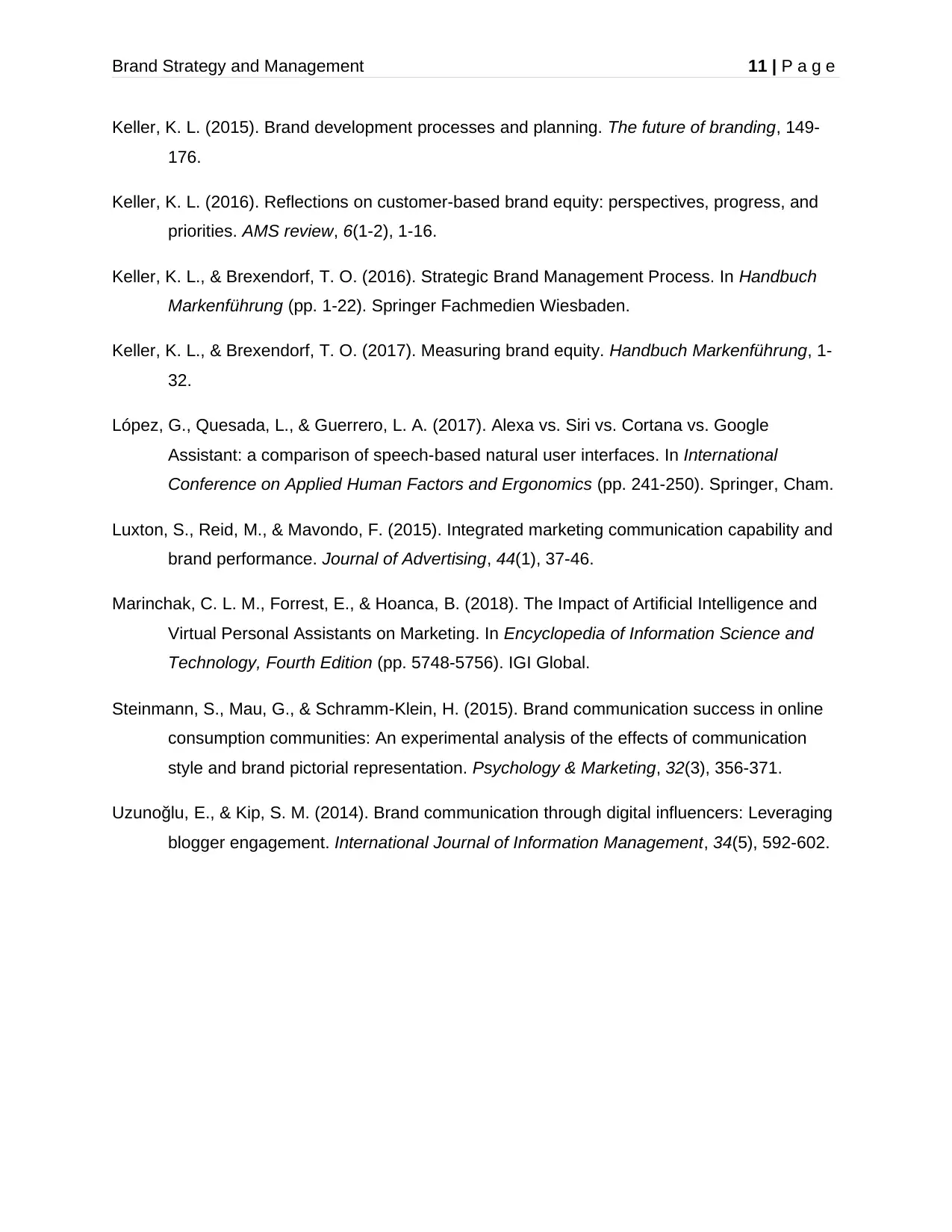
Brand Strategy and Management 11 | P a g e
Keller, K. L. (2015). Brand development processes and planning. The future of branding, 149-
176.
Keller, K. L. (2016). Reflections on customer-based brand equity: perspectives, progress, and
priorities. AMS review, 6(1-2), 1-16.
Keller, K. L., & Brexendorf, T. O. (2016). Strategic Brand Management Process. In Handbuch
Markenführung (pp. 1-22). Springer Fachmedien Wiesbaden.
Keller, K. L., & Brexendorf, T. O. (2017). Measuring brand equity. Handbuch Markenführung, 1-
32.
López, G., Quesada, L., & Guerrero, L. A. (2017). Alexa vs. Siri vs. Cortana vs. Google
Assistant: a comparison of speech-based natural user interfaces. In International
Conference on Applied Human Factors and Ergonomics (pp. 241-250). Springer, Cham.
Luxton, S., Reid, M., & Mavondo, F. (2015). Integrated marketing communication capability and
brand performance. Journal of Advertising, 44(1), 37-46.
Marinchak, C. L. M., Forrest, E., & Hoanca, B. (2018). The Impact of Artificial Intelligence and
Virtual Personal Assistants on Marketing. In Encyclopedia of Information Science and
Technology, Fourth Edition (pp. 5748-5756). IGI Global.
Steinmann, S., Mau, G., & Schramm‐Klein, H. (2015). Brand communication success in online
consumption communities: An experimental analysis of the effects of communication
style and brand pictorial representation. Psychology & Marketing, 32(3), 356-371.
Uzunoğlu, E., & Kip, S. M. (2014). Brand communication through digital influencers: Leveraging
blogger engagement. International Journal of Information Management, 34(5), 592-602.
Keller, K. L. (2015). Brand development processes and planning. The future of branding, 149-
176.
Keller, K. L. (2016). Reflections on customer-based brand equity: perspectives, progress, and
priorities. AMS review, 6(1-2), 1-16.
Keller, K. L., & Brexendorf, T. O. (2016). Strategic Brand Management Process. In Handbuch
Markenführung (pp. 1-22). Springer Fachmedien Wiesbaden.
Keller, K. L., & Brexendorf, T. O. (2017). Measuring brand equity. Handbuch Markenführung, 1-
32.
López, G., Quesada, L., & Guerrero, L. A. (2017). Alexa vs. Siri vs. Cortana vs. Google
Assistant: a comparison of speech-based natural user interfaces. In International
Conference on Applied Human Factors and Ergonomics (pp. 241-250). Springer, Cham.
Luxton, S., Reid, M., & Mavondo, F. (2015). Integrated marketing communication capability and
brand performance. Journal of Advertising, 44(1), 37-46.
Marinchak, C. L. M., Forrest, E., & Hoanca, B. (2018). The Impact of Artificial Intelligence and
Virtual Personal Assistants on Marketing. In Encyclopedia of Information Science and
Technology, Fourth Edition (pp. 5748-5756). IGI Global.
Steinmann, S., Mau, G., & Schramm‐Klein, H. (2015). Brand communication success in online
consumption communities: An experimental analysis of the effects of communication
style and brand pictorial representation. Psychology & Marketing, 32(3), 356-371.
Uzunoğlu, E., & Kip, S. M. (2014). Brand communication through digital influencers: Leveraging
blogger engagement. International Journal of Information Management, 34(5), 592-602.
1 out of 11
Related Documents
Your All-in-One AI-Powered Toolkit for Academic Success.
+13062052269
info@desklib.com
Available 24*7 on WhatsApp / Email
![[object Object]](/_next/static/media/star-bottom.7253800d.svg)
Unlock your academic potential
© 2024 | Zucol Services PVT LTD | All rights reserved.





